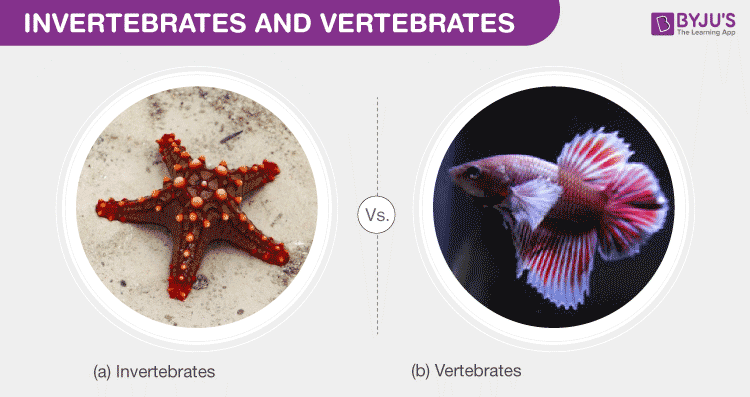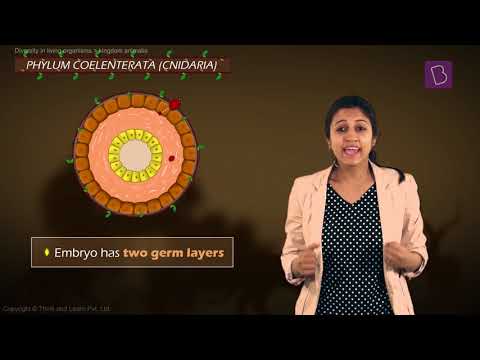In the animal kingdom, animals have been classified into two main categories based on the presence or absence of the backbone or a spinal column. Apart from this, there are more differences between vertebrates and invertebrates. Read on to explore how these classes of organisms differ from each other.

Differences Between Invertebrates And Vertebrates
|
Invertebrates |
Vertebrates |
| Invertebrates do not possess a backbone not an internal skeleton | Vertebrates possess a backbone and an internal skeleton. |
| Invertebrates have an exoskeleton | Vertebrates do not possess an exoskeleton. |
| Body size varies but most are generally smaller than vertebrates. However, some invertebrates grow to gigantic proportions – such as the colossal squid (46 feet in length) | Generally, vertebrates are comparatively larger than invertebrates |
| Nearly all invertebrates possess an open circulatory system. | All vertebrates have closed circulatory systems. |
| A majority of invertebrates have compound eyes. | Vertebrates do not have compound eyes. |
| Includes radial or bilateral body symmetry. | All vertebrates have bilateral body symmetry. |
| Presence of a simple and unorganized nervous system. | Presence of complex and highly specialized organ systems with specific functions. |
| Mode of nutrition includes Autotrophic, Parasitic and Heterotrophic. | Mode of nutrition is usually heterotrophic. |
| 95% of animal species are invertebrates. | 5 % of animal species are vertebrates. |
| Flatworms, arthropods, sponges, insects are a few examples of Invertebrates. | Mammals, fish, reptiles, amphibians, and birds are examples of Vertebrates. |
Invertebrates
Invertebrates can be simply identified as animals that do not have a backbone. They are found almost everywhere, from the hottest deserts and the deepest seabeds to the darkest caves and the tallest mountains.
As stated before, invertebrates are the animals which mainly lack a skeletal system. This means most of them do not possess a rigid body structure and as a result, cannot grow very large. Anatomically, most invertebrates have an open circulatory system where blood flows in an open cavity. Most invertebrates also possess a simple respiratory system, with the most common form being gills and trachea.
To compensate for the lack of an internal skeleton, most invertebrates have an external skeleton that protects their soft, inner body. This material is usually made from chitin, a derivative of glucose.
Invertebrates constitute more than 97 per cent of all species in the animal kingdom. The number of invertebrates exceeds more than 2 million species, with more being found almost every other day.
Prominent examples include annelids, arthropods, bivalves, coelenterates, echinoderms, squid, sponges, snails, and octopuses. Some invertebrates possess far superior traits and features to that of vertebrates. For instance, did you know the largest eye in the animal kingdom belongs to the colossal squid – a gigantic invertebrate?
Read More: Invertebrates
Vertebrates
Vertebrates are the most advanced of species in the animal kingdom. Members possess a well defined internal skeleton system, which includes a backbone. In humans, the spinal cord runs along the body between the caudal and cranial regions connecting to the nerve tissues. Vertebrates also have more complex and specialized organ systems when compared to invertebrates. Organ systems like the respiratory systems are quite complex, with many additional functions. Even the sensory organs are advanced, which helps vertebrates adapt to their respective environment.
On average, the overall count of vertebrates existing on planet earth is around 57,000 to 58,000.
Examples of vertebrates include all chordates such as mammals, birds, fish, reptiles, and amphibians etc. The main characteristics of the vertebrates are that members have bilaterally symmetrical bodies and a brain enclosed by a skull.
Read more: Chordates – Definition and Examples

Frequently Asked Questions
1. How are animals classified?
One of the most well-known and primary methods of classifying animals is based on the presence or absence of the backbone. And there are two classifications that fall under it, namely vertebrates and invertebrates.
2. Briefly explain the characteristics of invertebrates.
One of the most primary characteristics is the absence of a spinal cord. This means that the members under this class also lack a hard, bony internal skeleton. However, in some members, a hard, exterior structure called the exoskeleton is present, which provides structural strength and protection from predators and environment (e.g., crabs, lobsters and ammonites.) Most of the members are motile, but there are exceptions like the sea sponge.
3. Briefly explain the characteristics of vertebrates.
Vertebrates are more complex organisms when compared to invertebrates. The primary difference between the two is that vertebrates possess a backbone and an internal skeleton. In some vertebrates, the bones are replaced with cartilage, as seen in sharks. Another defining characteristic of vertebrates is that they reproduce sexually.
Learn more about invertebrates and vertebrates and their differences only at BYJU’S Biology.

I just loved it
It is the simplest way of learning through Byjus
Superb! Help me have a good understanding
outstanding it is the simplest way of learning
Good for writing in the project.
And understanding ????
wow this is too helpful